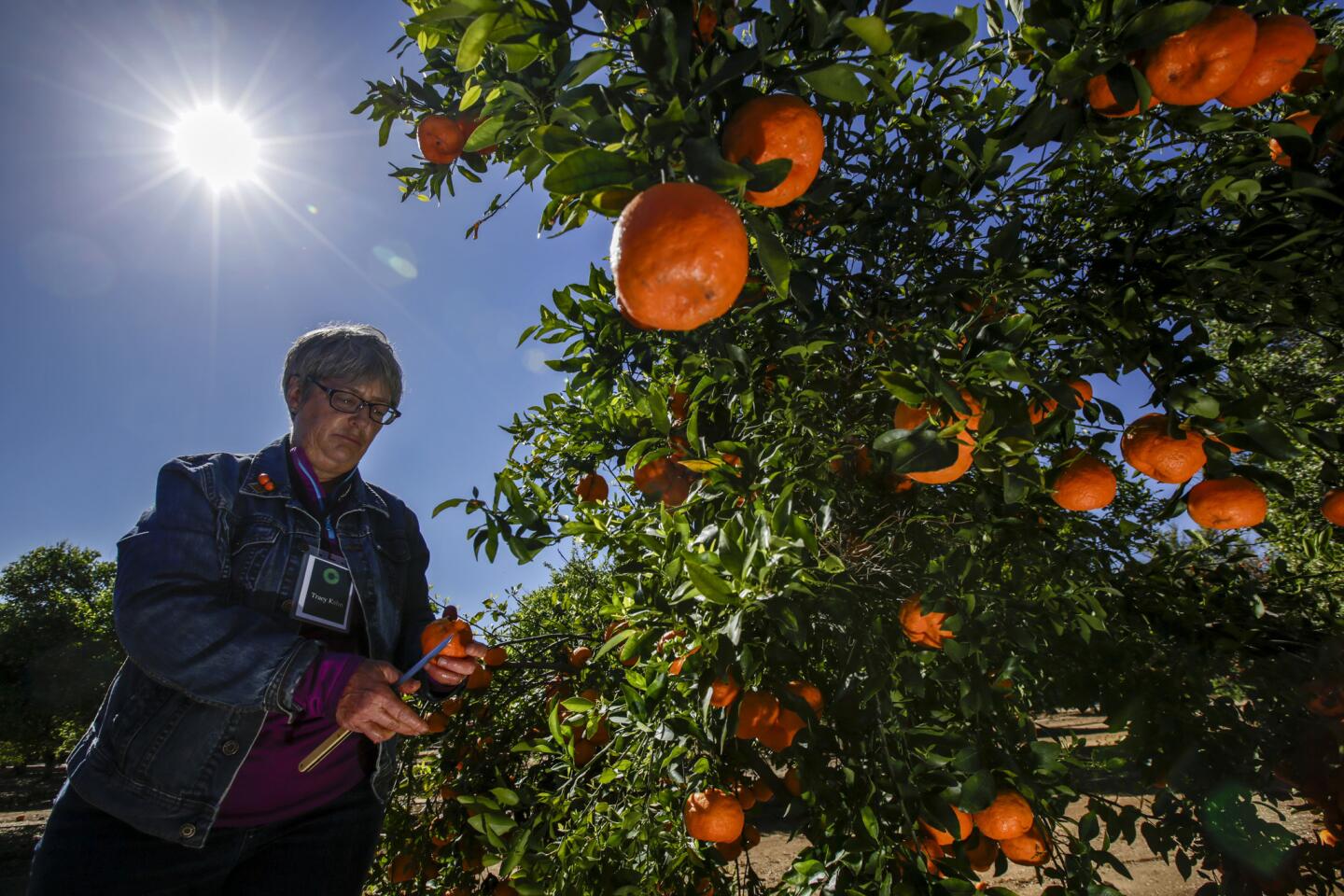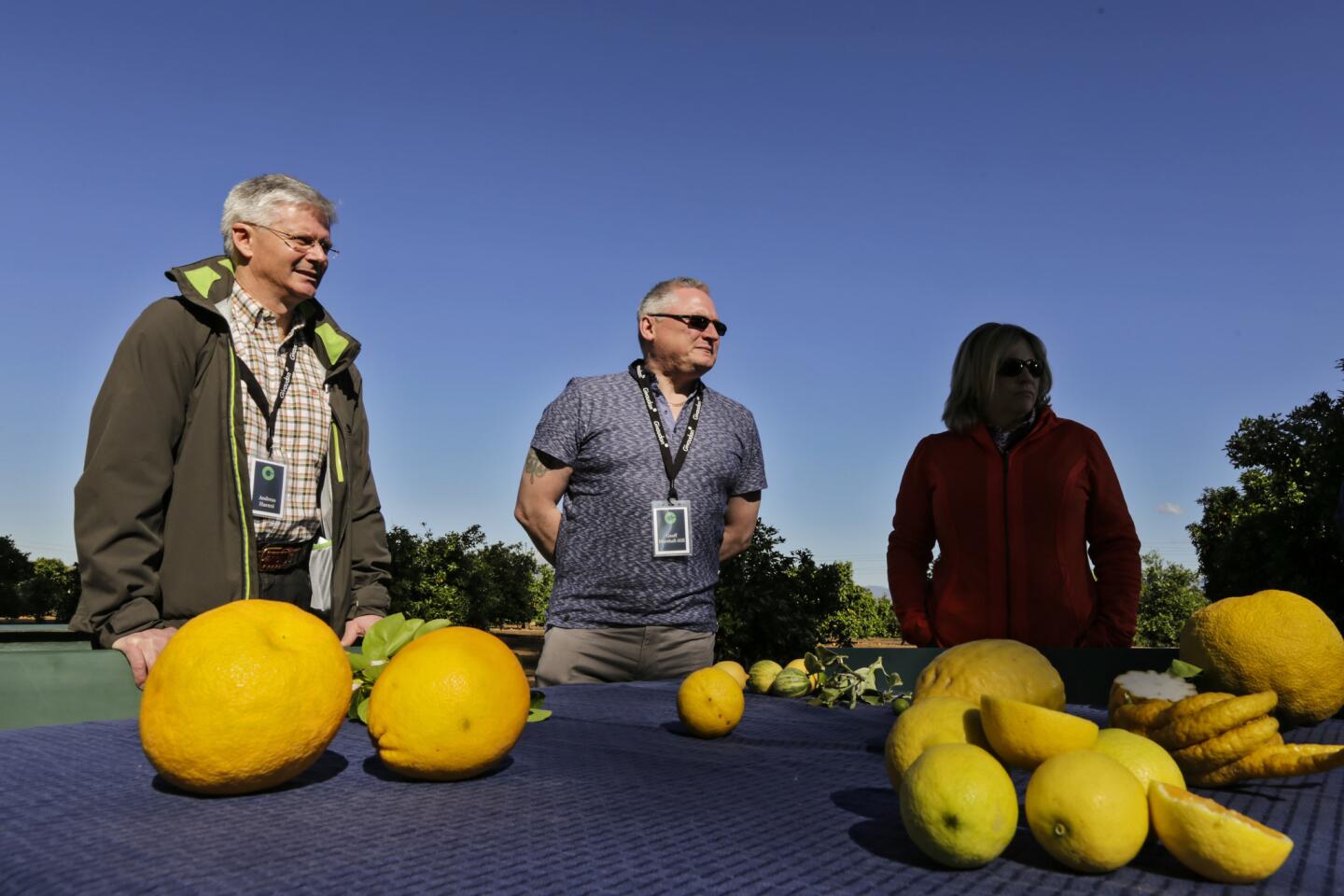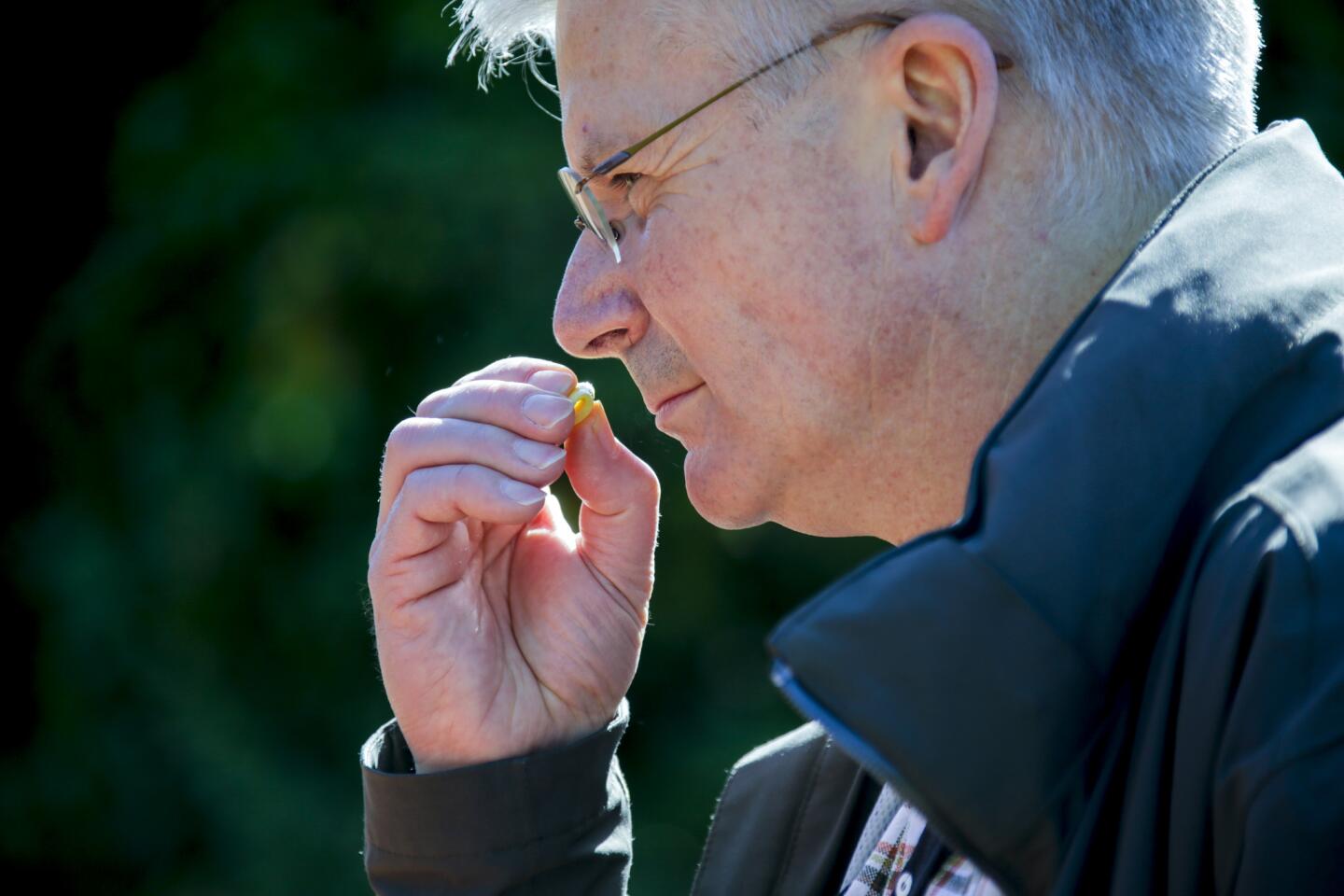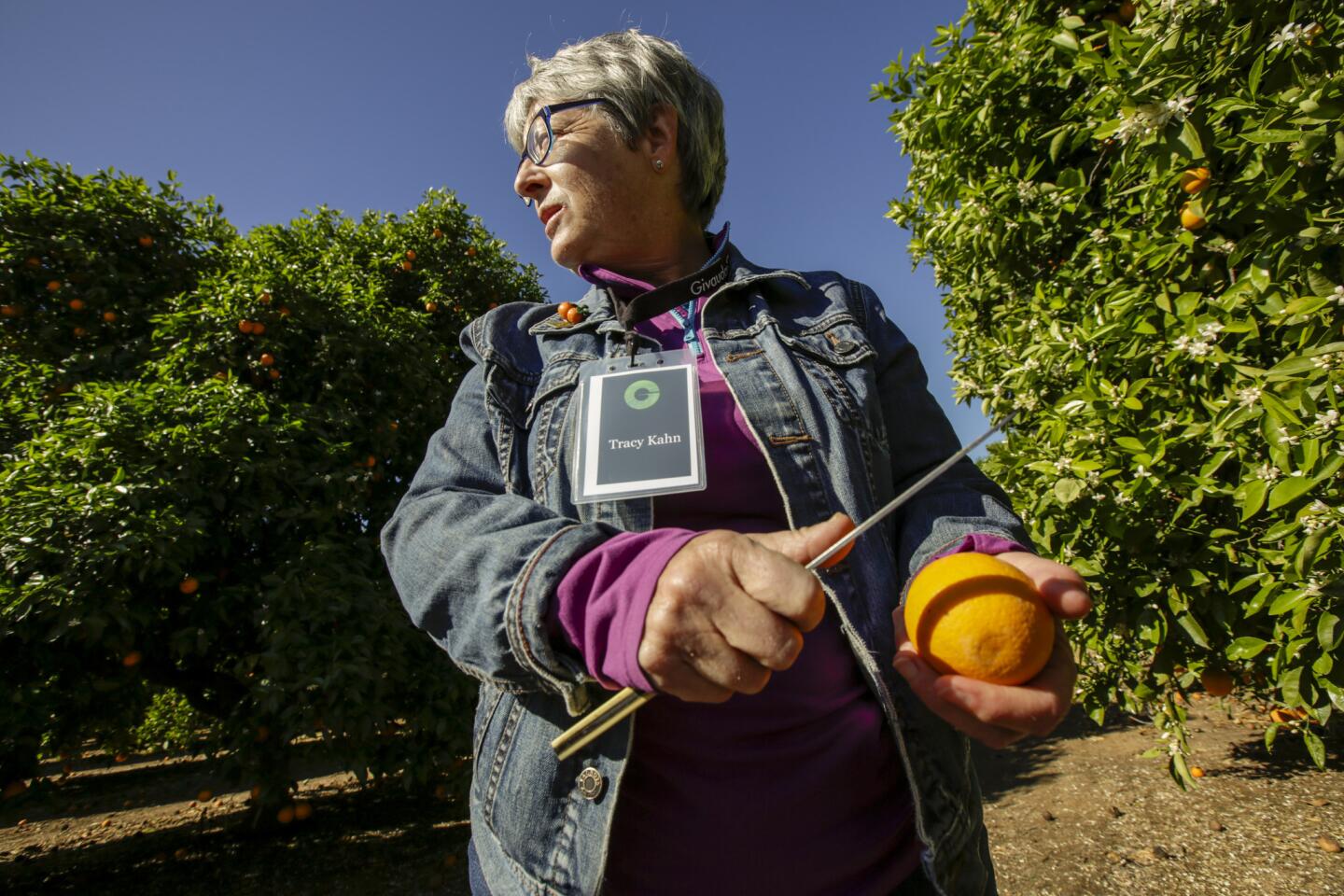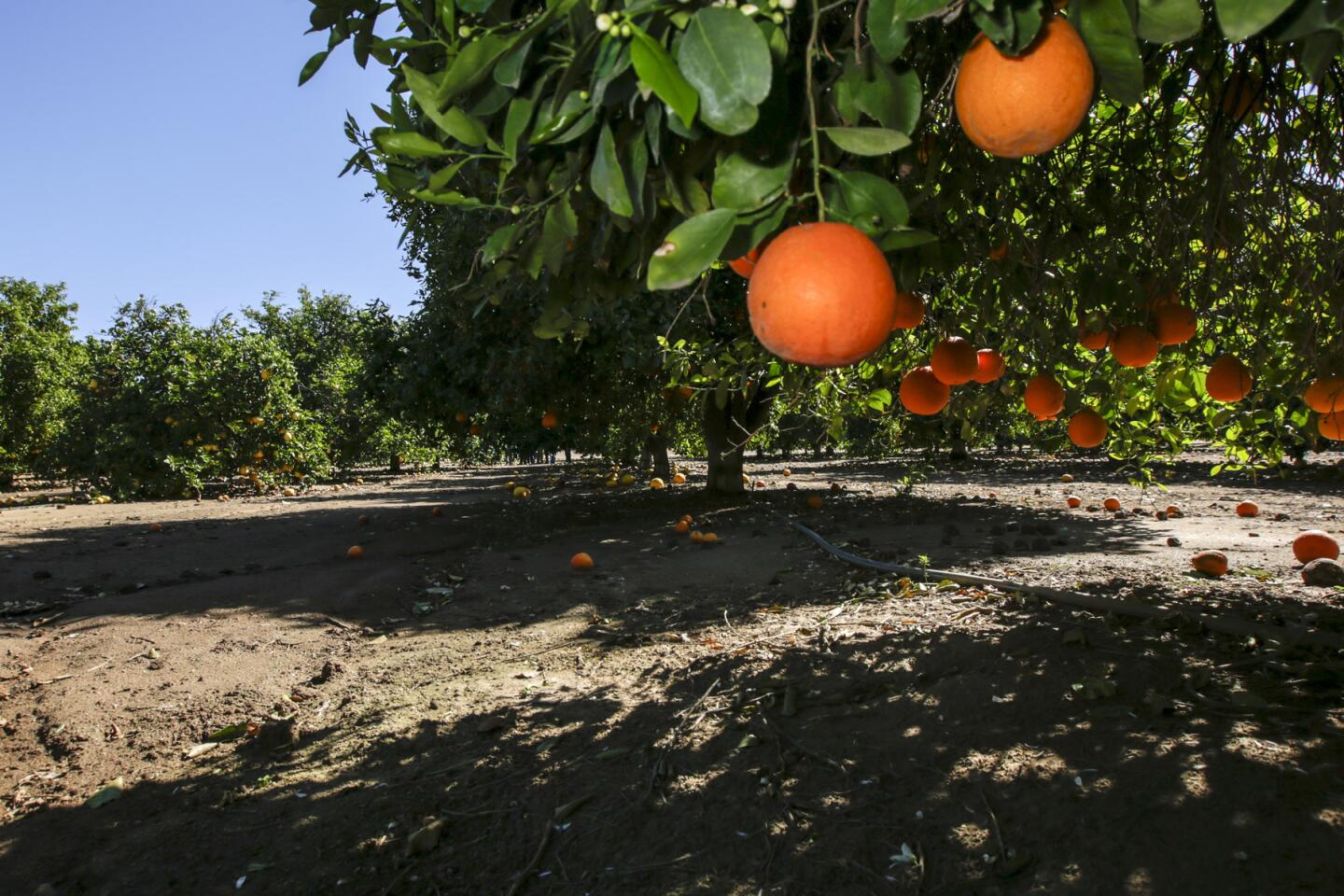Great Read: A peek into the mysterious art of citrus flavoring
- Share via
Geoff Marshall-Hill finds the tango mandarin’s scent “a bit catty.” He can’t even imagine a market for the Indio mandarinquat. But the rich wine and berry undertones of the sanguinelli blood orange elicits a string of superlatives.
He wanders a dusty orchard in Riverside, surrounded by co-workers who watch each morsel that goes in his mouth, and heed every bon mot that comes out. Because when it comes to taste, this 57-year-old Brit has the kind of palate that can influence the worldwide market in food and beverages.
Marshall-Hill is a principal flavorist for Givaudan, the largest manufacturer of flavorings and fragrances in the world. The Swiss company has dispatched its flavorists to jungles in Gabon and to vanilla farms in Madagascar.
But it always comes back to these 22 acres near the rocky flanks of Mt. Rubidoux, which harbor a taster’s menu of the more than 1,000 varieties of citrus collected, cultivated and cross-bred for more than a century by UC Riverside.
It’s a living genetic library stretching from the Abhayapuri lime to the zhuluan sour orange, and in 10 years Marshall-Hill and his colleagues have sampled only about 20% of it. On this day, they’ll explore about a dozen more, in search of something that will pique the palates of consumers and keep the company atop one of the most opaque and cutthroat niches in the food industry.

Geoff Marshall-Hill is principal flavorist for Swiss-based Givaudan, the largest manufacturer of flavorings and fragrances in the world.
Last year, Givaudan forked over $1 million to UC Riverside for the privilege, creating the Givaudan Citrus Variety Collection Endowed Chair. The current occupant, Tracy Kahn, longtime curator of the collection, greets Marshall-Hill with a mother-of-pearl handled grapefruit knife. She pares open a tango mandarin, a variety developed at Riverside that now grows on several million trees statewide.
“You probably have eaten it because this is what you find in Cutie and Halo boxes,” she explains. “Those are trademark names for what are usually multiple cultivars: clementines before Christmas — usually fina sodea clementines or clemenules — then after Christmas the W Murcott afourer and tango. But mostly tango.”
Marshall-Hill flexes the rind, releasing an oily mist below his nose, and inhales.
“This one’s quite sulfury; it’s a bit catty — cat’s pee,” he says. “Not necessarily a bad thing. It’s something you normally associate with grapefruit. Quite often with a fresh peel, it brings a very slight twinge to the profile.”
As for the fruit itself: “This is particularly succulent, particularly juicy — all the standard descriptions we’d use,” he says. “But is there anything that’s standing out? No. It’s just a really well-balanced mandarin-type profile…. This is pretty mainstream, but delicious.”
Marshall-Hill, a brawny man who sports a Celtic cross on his right biceps, approaches his job with self-effacing humor. All he wanted was enough money for a car when he applied for a flavorist job 40 years ago at an essential oils company in his native Milton-Keynes, about 45 miles northwest of London.
Several mergers and acquisitions later, he’s risen to the top tier of tasters at the top company in the field. Except for a few years at the company’s North American headquarters in Cincinnati, though, Marshall-Hill has mostly stayed in his hometown, a planned city that is famous lately for having the highest percentage of overweight or obese people in England.
I don’t want to be a sensitive taster. Because most of the population aren’t sensitive tasters. What I think sometimes doesn’t even matter at all -- it’s what consumers think.
— Geoff Marshall-Hill, principal flavorist for Givaudan
“I don’t consider myself a very sensitive taster,” Marshall-Hill says. “I don’t want to be a sensitive taster. Because most of the population aren’t sensitive tasters. What I think sometimes doesn’t even matter at all — it’s what consumers think.”
What consumers think about taste, though, is founded largely on misconceptions.
“To the layperson, when they’re talking about taste, they’re talking about the experience of when they eat or drink something or otherwise put it in their mouth, and that’s not just taste,” said Jeannine Delwiche, a New York-based sensory scientist and consultant who has worked in academia and industry.
When scientists talk about taste, they’re talking about an experience cobbled together as much from scent, suggestion and memory as from the nerve endings in the mouth and tongue, which detect only sweet, sour, bitter, salty and the savory “umami” of meats. (There is some debate about a sixth “fat” sensation.)
“Honestly there’s not a lot of variation in the taste compounds,” said Delwiche, who has degrees in psychology and food science. “They’re looking more at compounds that contribute to smell.”
Many of those compounds, Marshall-Hill explains, are found in the part consumers generally don’t eat: the rind. It’s his job to identify them and find ways to use them.
That exercise in molecular cuisine amounts to a $25-billion industry, led by Givaudan, fellow Swiss company Firmenich, New York-based International Flavor and Fragrances Inc. and Germany’s Symrise.
“We take things apart, play with them and build it back again,” Marshall-Hill says. “Nature gets it every day. We try in our own way to do something that approaches that, in however clumsy a way that we can.”
So, amid argot worthy of a sommelier — green, floral, herbaceous, tea-like — Marshall-Hill tosses out references to terpenes, isobutyrates, esters and anthranilates, terms he has picked up in formal training.
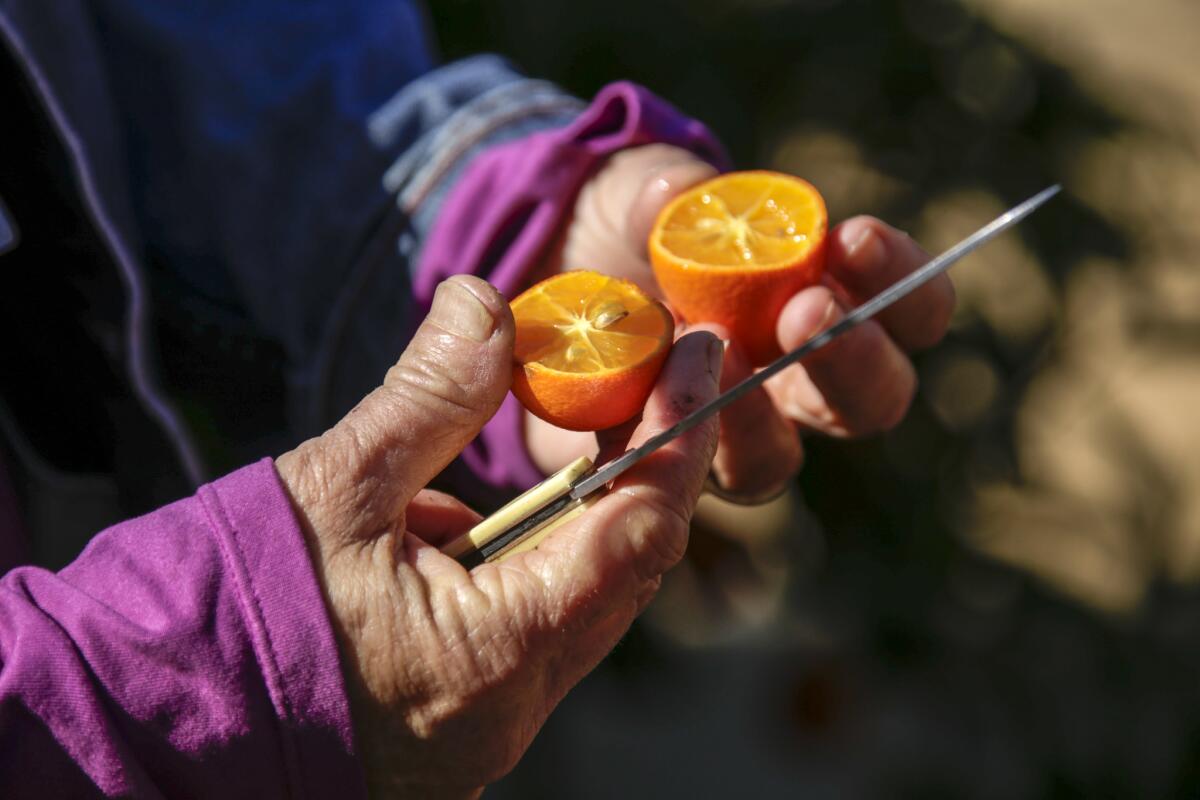
Tracy Kahn slices a variety of citrus fruit for a group of flavorists from Givaudan visiting UC Riverside’s Citrus Variety Collection. Givaudan, a Swiss company, uses the facility for inspiration and creating new flavors for its clients.
Most of his work, he knows, is lost on the consumer. The flavor industry’s contribution to a drink or candy often is identified only as “natural” or “artificial” flavor (Food and Drug Administration rules differentiating the two run six pages.). Consumers can reach for an “orange” sports drink, or one with an ambiguously named “rain” or “silver ice” flavor.
Givaudan plays little more than an advisory role for its clients, who use marketing alchemy to reconstruct flavoring back into what consumers mean by the experience of “taste.”
Like most fragrance and flavor companies, Givaudan’s discretion about naming those clients borders on the Mafia’s omerta. (Givaudan representatives once flew to Atlanta to apologize to Coca-Cola for an employee’s casual mention of having crafted a vanilla flavoring for Coke, according to New Yorker writer Raffi Khatchadourian, who profiled the company in 2009.)
Marshall-Hill and the rest of the Givaudan coterie wander the rows of the citrus collection, repeating the liturgy of slice, sniff, chew and chat. As morning approaches noon and the Inland Empire’s heat rises, they linger longer under boughs of trees, and eat extra slices of fruit proffered by Khan: meiwa kumquat and ponkan mandarin, then tarocco, sanguinelli and morro blood oranges, a clear favorite of Marshall-Hill.
“They give so much differentiation from all other oranges,” he says. “It’s much more complex; it brings ingredients that are not really prominent in any of the other orange varieties. It’s just like a rich, wine, berry — that is so fruity.”
And that is just the scent from the rind.
“The old flavorist trick for blood oranges is to combine orange and raspberry,” Marshall-Hill says. “When you taste it in the real flesh you realize just how poor that analogy is.”
Marshall-Hill has a more complicated “memory” of the taste stored in his laptop. Back at Givaudan’s temporary headquarters in a conference room of the Mission Inn, he wires the computer to an aluminum-clad suitcase that opens to reveal 29 cigar-sized cartridges, each marked with a scent component, including “catty,” which is more diplomatically named sulfur.
The James Bond-worthy contraption is essentially a scent mixing board. The company often lends it to distant customers or Givaudan branches, so each party can smell formulations and adjust them, using a proprietary language to describe every element. It’s as close as it gets to Smell-O-Vision.
Marshall-Hill attaches a vial of juiced sanguinelli blood orange to one cartridge, and forces air through it and into a set of three face masks. He invites visitors to inhale the scent. Then he switches to the laptop’s synthetically constructed fragrance.
Visitors agree it is similar, but somehow weak in berry tones. He adjusts dials, but it becomes more “lemony.”
The goal, he explains, is less to get an exact copy than to discover something that lifts flavors above generic profiles, such as “orange” or “lemon-lime” that dominated the food and beverage palate for much of Marshall-Hill’s 40 years in the craft.
“There is no: ‘This is an iconic orange, full-stop, pack me bags, go home, I don’t have to work again for the rest of my life,’” he says.
For the flavor industry and even more so for its food and beverage clients, launching new flavors amounts to an expensive guessing game akin to fashion designers deciding what colors will be in next season.
“They like novelty,” Delwiche said. “Not all of them, but many of them do. And they like flavors to be from a natural source. But that’s a bit of a conundrum, because if it’s from a natural source, unless you’re blending it, it’s not going to be novel. So, what they’re trying to do is find the familiar, but novel experiences.”
This year, the spice company McCormick has predicted that the more adventurous consumers will veer toward tropical Asian flavors, heat and tang combinations and mixed drinks inspired by culinary techniques, such as pickling, roasting or caramelizing.
But while one consumer may reach for a peach and vanilla brulee mixed drink that harks back to a vacation, another may just want to quaff an orange soda recalled from childhood.
Marshall-Hill is determined to please both. He’s grateful to have 1,000 trees from which to choose.
ALSO
Despite the hype for Tesla’s Model 3, electric car sales are far from robust
More to Read
Inside the business of entertainment
The Wide Shot brings you news, analysis and insights on everything from streaming wars to production — and what it all means for the future.
You may occasionally receive promotional content from the Los Angeles Times.
